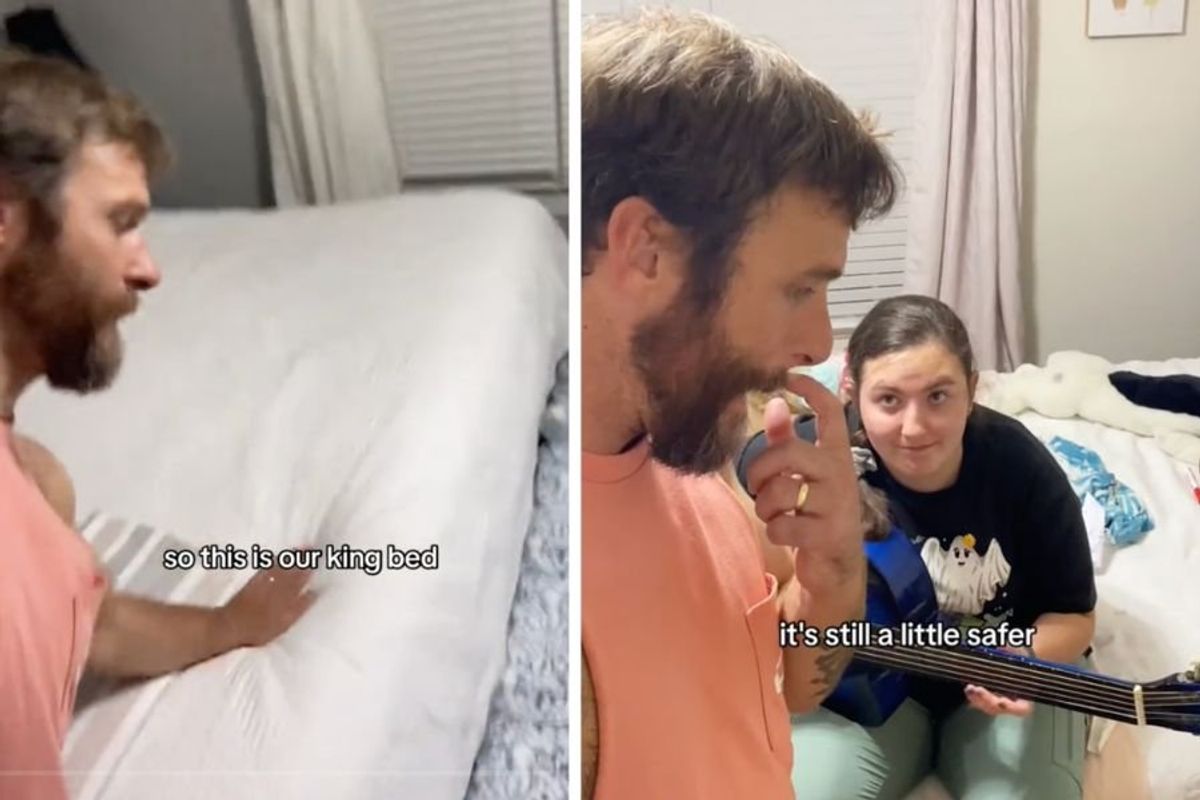Dad and tween daughter show how their family 'co-sleeps' together
Their viral video has people debating when co-sleeping should end.

Co-sleeping asa family might not be mainstream anymore, but it was once totally the norm.
Like virtually any aspect of parenting, co-sleeping, aka bed sharing, can be a bit of a controversial topic.
Sleeping together as a singular family unit is a much older practice, dating as far back as the Medieval Era—when sleeping separately was both unsafe and unattainable for most.
Today, it is generally recommended to have children sleeping on their own by the age of five, although plenty of parents will still share a bed with their 12 to 13-year-olds from time to time. In other words, there are no hard and fast rules—though many have strong opinions.
And while it certainly isn’t mainstream anymore, some families opt for the more classic sleeping approach.
Take the Deal family, for example.
In a video posted to TikTok, Brandon Deal and his 12-year-old daughter, McKenzi, show their unconventional sleeping layout.
“When people find out that we're a co-sleeping family, they think we all pile up on one bed. That is not the case,” Brandon says, explaining that he, his wife Megan, and their smaller daughter Sarah Grace share a king size bed, while McKenzi sleeps in her own twin size bed placed at the foot of the king-sized bed.
@deal_family Anyone else co-sleep?? #cosleeping #familygoals #parentsoftiktok ♬ original sound - The Deal Family
Brandon asks his daughter why she sleeps in the twin bed in their bedroom, to which she replies, “I don't know, it's a little safer.” It’s unclear if she means sleeping in her own bed feels safer (lest she be whacked by three other pairs of feet) or that sleeping in the room with her family feels safer.
Brandon then says that when Sarah Grace potentially becomes “too big” to share the bed with her parents, that she’ll also get her own twin sized bed.
It wasn’t long before the clip received thousands of views on TikTok, with viewers sharing their bafflement at the arrangement.
“I can barely handle co-sleeping with my husband,” one person wrote.
Others were totally on board with the idea, even sharing their own co-sleeping stories.
One person commented, "You keep co-sleeping until those kiddos decide to sleep in their own beds ♥️”
Another added “We co-slept with our oldest til 12, our son til 10. We lived remote in the woods, my kids are grown and amazing keep doing you guys❤❤🙏.”
Still, others feared that the enmeshment could cause codependency issues long term, and get in the way of parents maintaining intimacy.
One person wrote, “As a child I know how safe it feels to sleep with your parents, but as a married woman I realize how important it is to not let my kids sleep w us.”
And while there’s perhaps validity coming from both sides of this argument, most behavioral experts would agree that neither choice is necessarily superior to the other. As James McKenna, PhD, an anthropologist specializing both in sleep behavior and infancy development says, "location is not as important as relationships—how parents build attachment and love.”
The Deal’s sleep strategy might not be suitable for others, but they have customized a plan that seems to work for them. May every family have the freedom and information they need to do the same.
This article originally appeared on 11.3.23





 Rihanna Nails GIF
Rihanna Nails GIF Good luck trying to catch a gazelle.
Good luck trying to catch a gazelle. Chickens will eat just about anything.
Chickens will eat just about anything. There's actually a big difference between horses and zebras besides just the stripes.
There's actually a big difference between horses and zebras besides just the stripes. People used to have actual maps in their cars.
Photo by
People used to have actual maps in their cars.
Photo by  We used to literally chart out long road trips on a physical map before departing.
We used to literally chart out long road trips on a physical map before departing. Google Maps shows crucial information about natural disasters like wildfires
Google Maps shows crucial information about natural disasters like wildfires